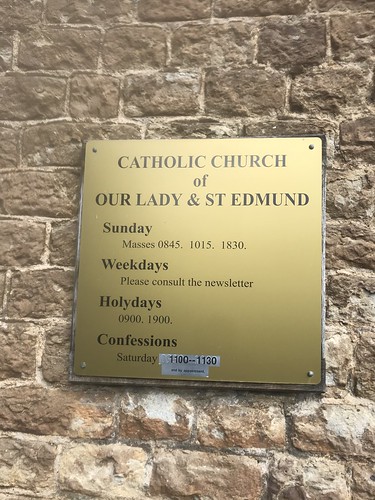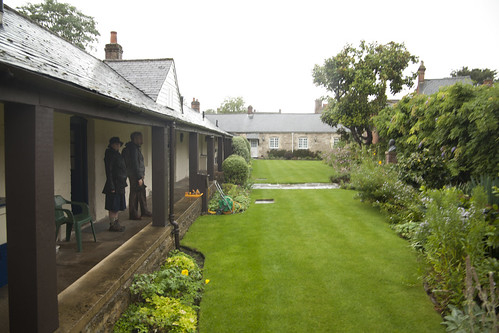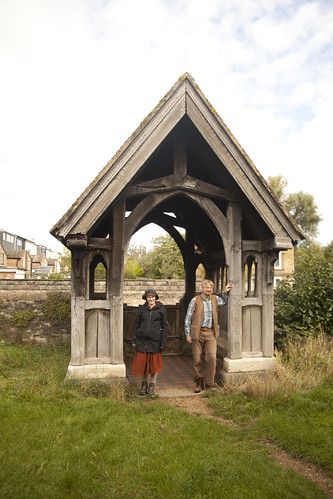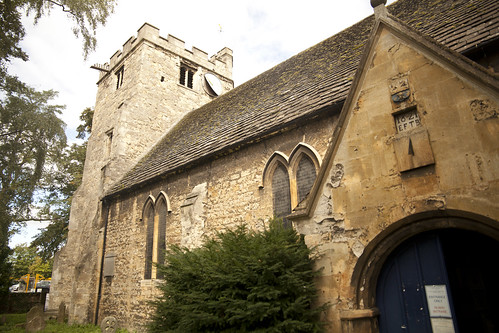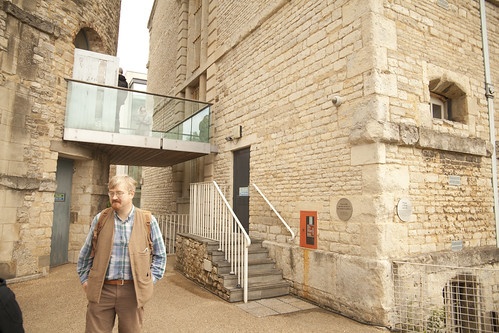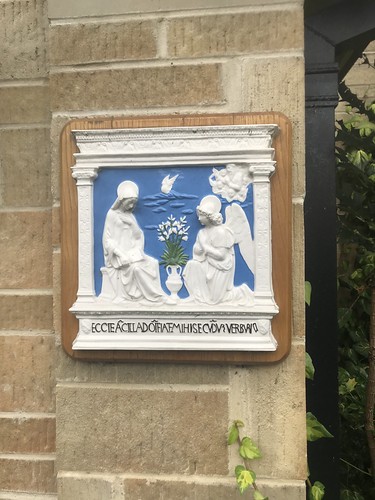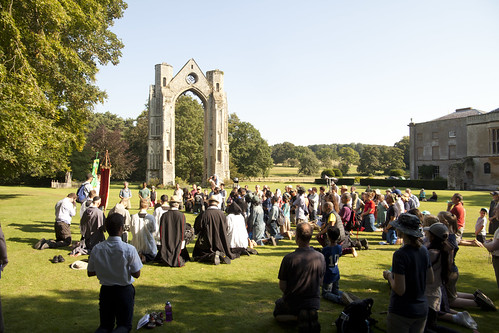Chairman's Blog
Interview in The Remnant
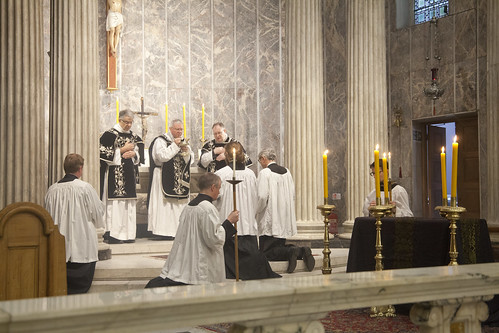 |
| High Mass of Requiem for Colin Mawby, Patron of the Latin Mass Society, in St Mary Moorfield, shortly before the Coronavirus epidemic. |
Q. Isn't the intellectual conception behind this dedication to the Tridentine Mass just another form of "antiquarianism"?
Joseph Shaw: ...The question can be approached from a subjective or an objective perspective. Subjectively, it is legitimate to ask what forms of liturgy and what devotions are most helpful to souls. Some may be of particular benefit to some Catholics, and others to others. Some like the Divine Office, or the Chaplet of the Seven Sorrows of Our Lady, but they are not compulsory, and to say one legitimate devotion or liturgical form is outdated or inappropriate for the current year is ridiculous. If it has been approved the Church, and someone finds it helpful, that is all that needs to be said.
...
In this way Pope Benedict XVI noted in his Letter to Bishops accompanying Summorum Pontificum, “it has clearly been demonstrated that young persons too have discovered this liturgical form, felt its attraction and found in it a form of encounter with the Mystery of the Most Holy Eucharist, particularly suited to them.” This should be a knock-down argument. Who could possibly object to young people deriving graces from one of the Church’s many liturgical forms?...
Nevertheless, there is an objective side to the question as well, and here Catholics attached to the ancient liturgical tradition face ceaseless attacks. ...
What is surprising is to be having these discussions within the Church, and not just with Protestants and non-believers. When Catholic opponents of the Traditional Mass say that ceremonies and prayers used for eight or a dozen centuries throughout the Latin Church are theologically misguided, they are not just criticizing of a small group of cranks found at the fringes of the Church today, but the Catholic Church as a whole. They are saying that the Church got it wrong: that in her most intimate inner life, she offered her children stones instead of bread, not in this or that place, not for some years or decades, but everywhere and for the great majority of her history. It is an argument for what Luther called the “Babylonish captivity of the Church”: that the Church went horribly wrong at a very early date, and needs to be turned upside down to correct it.
...
Assertions such as “the ancient Offertory Prayers are erroneous because they treat the Host as if it had already been consecrated”, or “the silent Canon wrongfully excludes the people from participation in the Mass” cannot be right: they are ultimately incompatible with the Catholic Church being the true Church. They should prompt us to think again about these issues until we can understand the meaning and purpose of these aspects of the Mass correctly. ...
Q. For many apologists of the replacement of Tridentine Liturgy by the new mass, this is the main motivation: the modern man, whose mentality is totally influenced by “science”, can no longer understand complex rituals and sacred symbols. Consequently, the religious language must be completely changed, transformed, replaced by something self-explanatory.
Joseh Shaw: ... The problem then is not the question of change in itself, or the ultimate goal of changes. It is rather this idea that ‘modern man’ can’t understand complex rituals and symbols. We should notice right away that this claim, if accepted, has almost exactly the same results as the Protestant claim that Catholic ritual is idolatrous, and the Enlightenment claim that it is obscurantist, and indeed both these claims find echoes in the writings of Catholic liturgical progressives, though not in magisterial documents. In its practical results, it serves to align the liturgy with the ethos of the intellectual elite which emerged from Protestantism and the Enlightenment.
This is clearly not a coincidence, and it should make us suspicious of it as an empirical claim. The Protestant Reformers and the anti-clerical intellectuals of the Enlightenment did not imagine that the mere passage of time had made or would make people less receptive to ritual. They saw, to their frustration and grief, that people found it very attractive and were deeply formed by it; they found that frequently the only way to counter its appeal was through physical violence.
The same frustration can be seen in the writings of some members of the Liturgical Movement before the Second Vatican Council, and liturgical progressives after it, when they admit that ordinary Catholics had no wish for a liturgical reform, and continued to hanker after the old Mass when it had been taken from them. Even where the changes were accepted more readily, no one could claim that they has answered widespread demands. Even the bishops, whose views were sought in a survey in preparation for the Council, showed very limited interest in a root-and-branch reform of the liturgy (this is documented by Annibale Bugnini himself). Partisans of the reform simply say that the reform was good for the people, and if the peoople did not realize this, this demonstrated their ignorance. ...
Joseph Shaw: The liturgical tradition stretching from Pope Gelasius, and before him, to the Traditional Mass as we have it today, is a plausible candidate for a tradition which conveys to us God’s will about how he wishes to be worshipped. A liturgy put together in a few years by a set of committees orchestrated by Archbishop Bugnini is not a plausible candidate for this role: it would be ludicrous to suggest such a thing.
Clearly those who set up the Consilium and those who accepted its proposals were not thinking in the terms I have just used. They had been trained to think only in terms of Ecclesiastical authority and sacramental validity. This mindset remains widespread among conservative Catholics today. It undermines the idea of the liturgy as an act of worship, as opposed to a dignified and perhaps informative container for the sacraments. It is not surprising for Catholics with this attitude to fail to see the point of a formal act of worship without any sacraments: the public celebration of Vespers, for example, or the celebration of Mass when the Faithful cannot receive Holy Communion (as has happened during the present Coronavirus epidemic). They cannot see what is added to private prayer by the forms given to us by the Church for public prayer.
My weekend pilgrimage
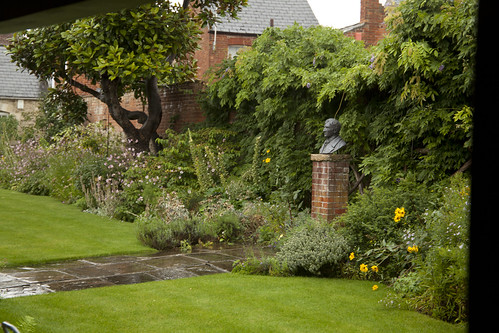 |
| Bust of St John Henry Newman in lay clothes in The College, Littlemore |
And thence to the Oxford Oratory, home of Our Lady of Oxford, our official destination, 5 1/2 miles from our lunch stop.
'Work hard, be nice' is not racist
 |
| Children doing the Stations of the Cross at the St Catherine's Trust Summer School in 2019. |
One of my favorite Twitter accounts is that of Katherine Birbalsingh (@Miss_Snuffy), the Headteacher of an experimental school in a deprived part of London, Michaela Community School. The experiment involves conveying knowledge to the children in an environment in which teachers and pupils do not live in constant fear of being assaulted. Naturally, this is an almost unique experiment, and she is constantly attacked by the progressive teaching establishment. There are precedents for her approach, however, and she expressed her dismay when one of these, the American Charter School chain KIPP, explained that in light of the Black Lives Matter movement that it had decided to change its motto and discipline policy. It explained:
We are retiring “Work hard. Be nice.” as KIPP’s national slogan; it ignores the significant effort required to dismantle systemic racism, places value on being compliant and submissive, supports the illusion of meritocracy, and does not align with our vision of students being free to create the future they want.
The obvious response to this statement is that if children cling to an attitude of angry non-cooperation toward their teachers, they are not going to learn anything or do well in any exams, and if they start off in deprivation, then they will stay there. KIPP, like Miss Birbalsingh’s school, has as its mission lifting children out of poverty and desperation, and if the school is giving up on that, this is a tragedy.
Sacramental validity matters
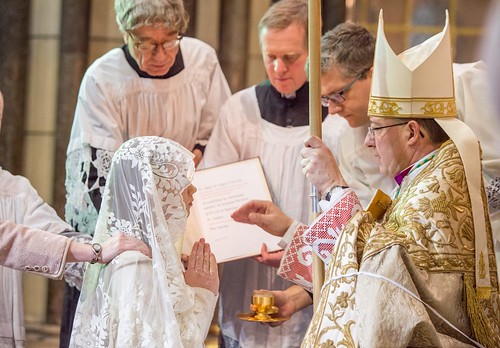 |
| The Sacrament of Confirmation. It won't be valid if your Baptism isn't valid, and Holy Orders won't be valid if your Confirmation isn't valid. |
The big story of the weekend came from the Archdiocese of Detroit. A certain Matthew Hood watched a video of his own baptism and realized that the officiant, a permanent deacon, had used an invalid formula: he had said ‘We baptize you’, not ‘I baptize you’. This was of special concern since Hood, now an adult, had been under the impression that he had been ordained a priest in 2017.
In some ways, the story is reassuring. It was a letter from the Congregation of the Doctrine of the Faith, under Pope Francis, insisting on the importance of these things, which set this chain of events into motion. The Archdiocese acted swiftly to have Hood properly baptized, confirmed, and ordained, and has done its best to reach other people baptized by the rogue deacon.
Two things remain worrying, however. One is that it is impossible to know how many other people are affected by invalid sacraments. The other is that many Catholic commentators seem not to care.
Take part in the LMS Walking Pilgrimage online this weekend!
Every year since 2010 the Latin Mass Society has had a walking pilgrimage from Ely to Walsingham, which is about 60 miles, for the conversion of England. This year we can't do it because of the Coronavirus: it would have taken place this weekend. Instead we are doing an online version, which you can take part in not only as a participant in live-streamed Masses and devotions, spanning the Shrine of Our Lady of Willesden, Our Lady of the English Margyrs in Cambridge, and the Slipper Chapel in Walsingham, the restored Catholic shrine to Our Lady of Walsingham.
Futhermore, you can join our prayer and penance by actually walking - whereever you are.
How will it work?
After the success of our July Digital Conference we will be bringing Pilgrims a daily schedule of Live-streamed Masses, Meditations, Online Rosary and prayer sessions live streamed on YouTube, Facebook and Zoom as we travel along our virtual route from Willesden in London to Walsingham over the three days. Pilgrims are invited to join in not just online but to get out if they are able and join the walk in their own locations.
Willesden to Walsingham is 118 miles. We need Pilgrims to pledge to walk a distance during the Pilgrimage which can be anything from half a mile to 100 miles! You can do your own pilgrimage in your back garden, in your street or even the local countryside, wherever you are in the world and whatever feels safe and suits you. You can even sign up to the Latin Mass Society Team on the Strava App and log your daily walks. With pilgrims signed up to the virtual pilgrimage walking and praying together we can add up the total of miles walked, along with the number of decades of the rosary said and even the number of songs sung as we pray this August to Our Lady of Walsingham.
How can l sign up?
On the Latin Mass Society website we are asking pilgrims to sign up as an individual or as a group and to pledge how many miles they intend to walk during the Pilgrimage.
See also the LMS YouTube channel:
https://www.youtube.com/watch?v=TlWv-H7tY34
The Facebook event:
https://www.facebook.com/events/3304042452966267/
Walkers can join the LMS Strava Group:
https://www.strava.com/athletes/33948101
Schedule
Friday, 28 August 2020
10:30 Mass from the Shrine of Our Lady of Willesden (courtesy of Fr Stephen Willis, Shrine Rector)
11:00 Introductory talk about the history of Walsingham and the meaning and importance of England being ‘Our Lady’s Dowry
11:15 Meditation from Fr John Cahill on the Meaning of Pilgrimage
11:30 Meditation - Fr James Mawdsley FSSP
11:45 Rosary and Reflection led by Fr Tim Finigan
12:05 Pilgrims' Walk
19:00 Compline
Saturday, 29 August 2020
11:45 Live-streamed Mass from Our Lady of the Assumption & English Martyrs, Cambridge
12:30 Meditations on the Feast of the Beheading of St John the Baptist from the Community of Our Lady of Glastonbury
13:00 Rosary and reflection led by Fr Tim Finigan
13:15 Pilgrims' Walk
19:00 Compline
Sunday, 30 August 2020
14:00 Live Streamed Mass from Walsingham
Bishops' onerous obligation
My latest on LifeSite
Bishops are discouraged by all sorts of things from performing their duties with the fidelity and vigor that the nature of their job enjoins. I don’t envy them. It is often said that many priests decline the offer of episcopal promotion, and it is not difficult to see why. But there is a big difference between saying that doing the right thing is very difficult and saying it is impossible. We can be obliged to do what is very difficult. We can’t be obliged to do the impossible: that is, really impossible.
What should bishops be doing? They have an obligation to safeguard the salvation of all the Catholics in their dioceses, so they must act against spiritual dangers to their flock. Thus, they are under an obligation to denounce ideas or individuals who present an urgent threat to their people’s spiritual welfare, and remove people from roles in the diocese, including schools, where they threaten people’s spiritual welfare.
This kind of thing must be done in an intelligent and strategic way, and there is nothing wrong in itself in a bishop minimizing bad publicity and observing his obligations as an employer and things like that. But it is difficult to avoid the impression that even many bishops who have a reputation for orthodoxy are not doing this intelligently and strategically: they are just not doing it.
LMS Virtual Walsingham Pilgrimage 28-30th August
LMS WALSINGHAM VIRTUAL PILGRIMAGE Friday 28th to Sunday 30th August |
Every year for the last 10 years the Latin Mass Society has held an annual Pilgrimage to Walsingham, walking from Ely in Cambridgeshire to Walsingham in Norfolk over three days during the August Bank Holiday weekend. This year, because of the Covid-19 Pandemic, we have decided to continue this tradition but this year it is to be a virtual pilgrimage from Willesden in north London to Walsingham, and we invite you to get involved. |
How will it work? We invite you to join the walk in your own locations; Willesden to Walsingham is 118 miles. We need pilgrims to pledge to walk a distance during the Pilgrimage, which can be anything from half a mile to 100 miles! You can do your own pilgrimage in your back garden, in your street or even the local countryside, wherever you are in the world and whatever feels safe and suits you. With as many pilgrims as possible signed up to the virtual pilgrimage, and all praying together, we can add up the total of the miles walked, along with rosaries said and songs sung, as we pray this August to Our Lady of Walsingham. The three day event will be streamed live on our Facebook page and Youtube channel. How can l sign up? How do I participate as a walker? We would then like to share your experiences during the Pilgrimage online and amongst our other pilgrims. If you are unable to join in with our walk then we hope you will pray for the pilgrims. |
New webite for the Catholic Medical Association, and their annual Requiem 14th November
It is time to admit that French Catholic Churches are under attack
My latest on LifeSite.
A Rwandan refugee who had been employed as a caretaker has confessed to starting the July fire at Nantes Cathedral, for reasons that remain obscure. The causes of the terrible 2019 fire that severely damaged Notre Dame in Paris may never be known. Fires can start for all kinds of reasons, but there is sadly a pattern of Catholic churches in France being deliberately burned down by people with a hatred for the Church and the Faith. There are, indeed, about 1,000 attacks a year.
The British weekly The Tablet recently reported:
“Something is happening in French society that's long been neglected but is becoming evident with these fires”, said Stefan Lunte, secretary-general of Justice and Peace Europe. “The country is becoming de-Christianized, and there are people who wish, for whatever reason, to vandalize and destroy Christian symbols ... The long-held strategy of keeping this under wraps simply does not work”.
The Justice and Peace movement is not normally associated with wild claims about culture wars, and as an adviser to the Commission of Bishops’ Conferences of the European Community, Lunte must be familiar with the safe and stodgy institutional mainstream of the Catholic Church in Europe. He is clearly fed up with it.
One problem with infallible canonisations
Dr John Lamont made the theological case against the infallible nature of decrees of canonisation on Rorate Caeli a couple of years ago: here's the first post, and here is a follow-up. The other day I stirred up Twitter by repeating some of his arguments and it didn't surprise me at all to see a fair amount of resistence to this idea from traditionally-inclined Catholics.
This follows very naturally from the fact that a lot of old books and old authorities say that canonisations are infallible. What one has to remember is that St Alphonsus and the rest used the term 'infallible' in a far looser way than Vatican I's definition, and when the term is used today it is that definition which tends to uppermost in our minds. Again, the process of determining the sanctity of individuals has been vastly, well, 'speeded up' would be a polite term. Saints generally needed four miracles to be canonised in the past, now they need two. And so on.
But I'm not going into all that again: Dr Lamont lays it all out. No one outside Twitter has ever seriously suggested that the infallibility of canonisations was itself a doctrine of the Church which requires the assent of Catholics. So we can agree to differ, as theologians in fact always have.
I want to point out something else which is of huge importance. The process of canonisation has always required money - the researchers have to be paid - and many of those canonised have well-funded supporters. Having rich chums does not in itself show that a person is not holy - even Christ had some rich friends, after all. But joined to a, ahem, streamlined process, there is a potential problem.
Among those being touted for canonisations there are bound to be celebrity Catholics backed by rich and powerful institutions associated with them which are determined to gain the prestige of having a founder or member canonised, and who fall below the moral standards of sanctity. We have seen how some of these institutions operate. The Legionaires of Christ were able to gain presigious endorsements not for a few years after concerns were raised, but for decades. They paid off some witnesses and denounced others. I think we are fortunate that the monster Macial died after being exposed.
It says something about the capacity of ecclesial institutions to discern who is holy and who is a career criminal that one after another of the founders of successful religious orders and institutions are found, often after their deaths, to have been evil men. The latest is Jean Vanier. A few years ago the suggestion that Vanier was anything other than a saint would have been shouted down by thousands of people genuinely moved and influenced by his work and writings. I don't blame them. Vanier was clever and he was careful. Are we quite sure that no one has been more careful?
At some point one of these individuals is going to be canonised. In fact, I would be very surprised if that hasn't already happened. Who could even read a short account of the life and work of all the people canonised since the system was, er, 'reformed' in 1983? There are thousands of them. But plenty of well-resourced people in the secular media will be happy to make it their business to find some dodgy ones.
One fine day in the next ten years credible allegations will be made against a beatus or canonised saint. Remember, you read it here first. And if we are not careful, the people defending the indefensible will be the conservative and traditional Catholics, the ones who want to defend the whole system and the very concept of heroic virtue and sanctity.
The liberals will just walk away from the shambles. Heck, they don't even believe in supernatural virtue, let alone miracles.
Those Catholics most queasy about the accelerated canonisation process, the ones most leery about canonising every Pope since Vatican II, the ones least comfortable about the scramble to find people to canonise who tick various ethnic and ideological boxes: these are the people who are going to be left to defend the 'St Jean Vanier' or the 'St Marcial Maciel' to be revealed in the future. As the details gradually emerge, as they tend to do, they will be utterly humiliated, and forever associated with the crimes of the accused.
My friends, you are walking into a trap.

